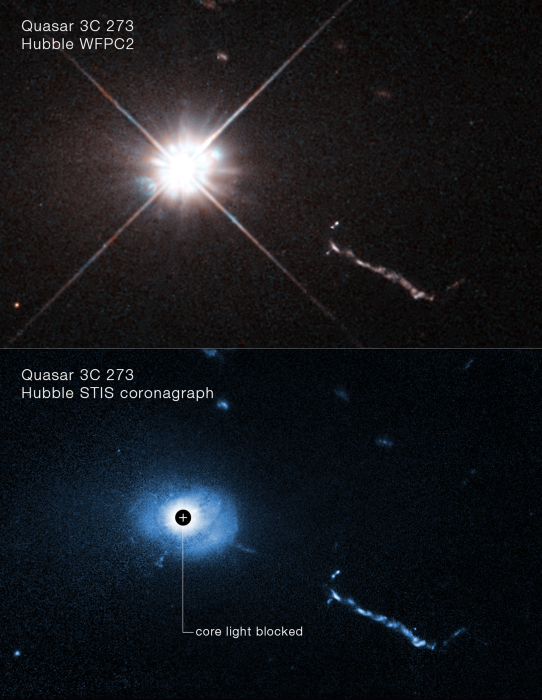Astronomers from NASA have been able to look deeper than ever before into the throat of a quasar powered by an energetic monster black hole with the help Hubble Space Telescope. A quasar is a brightly glowing galactic center that forms when a black hole eats up material in its immediate vicinity.
 A Hubble Space Telescope image of the core of quasar 3C 273. A coronagraph on Hubble blocks out the glare coming from the supermassive black hole at the heart of the quasar. This allows astronomers to see unprecedented details near the black hole such as weird filaments, lobes, and a mysterious L-shaped structure, probably caused by small galaxies being devoured by the black hole. Located 2.5 billion light-years away, 3C 273 is the first quasar (quasi-stellar object) ever discovered, in 1963. NASA, ESA, Bin Ren (Université Côte d’Azur/CNRS); Image Credit: John Bahcall (IAS); Image Processing: Joseph DePasquale (STScI)
A Hubble Space Telescope image of the core of quasar 3C 273. A coronagraph on Hubble blocks out the glare coming from the supermassive black hole at the heart of the quasar. This allows astronomers to see unprecedented details near the black hole such as weird filaments, lobes, and a mysterious L-shaped structure, probably caused by small galaxies being devoured by the black hole. Located 2.5 billion light-years away, 3C 273 is the first quasar (quasi-stellar object) ever discovered, in 1963. NASA, ESA, Bin Ren (Université Côte d’Azur/CNRS); Image Credit: John Bahcall (IAS); Image Processing: Joseph DePasquale (STScI)
According to Bin Ren of the Côte d'Azur Observatory and Université Côte d'Azur in Nice, France, the new Hubble views of the quasar's surroundings reveal many “weird things.”
We have got a few blobs of different sizes and a mysterious L-shaped filamentary structure. This is all within 16,000 light-years of the black hole.
Bin Ren, Université Côte d'Azur
The bright lighthouse may be powered by materials that will accrete onto the central supermassive black hole, which could be provided by some of the objects, such as tiny satellite galaxies falling into the black hole.
Thanks to Hubble's observing power, we are opening a new gateway into understanding quasars. My colleagues are excited because they have never seen this much detail before.
Bin Ren, Université Côte d'Azur
As point sources of light in the sky, quasars resemble stars, hence the term “quasi-stellar object.” The quasar studied in the new research, 3C 273, was first identified in 1963 by astronomer Maarten Schmidt as the first known quasar.
It was too far away for a star at 2.5 billion light-years. With a luminosity more than ten times that of the brightest giant elliptical galaxies, it must have been more energetic than anyone could have ever guessed. This led to a surprising new cosmological conundrum: what generates this energy? Material accreting onto a black hole was most likely the cause.
Hubble's new, sharp view in 1994 showed that the quasar environment is much more complicated than initially thought. According to the images, quasars and companion galaxies may have collided and merged, sending debris crashing into supermassive black holes. The massive black holes that fuel quasars are rekindled by this.
According to Hubble, gazing into quasar 3C 273 is like trying to see an ant crawling on the rim around a bright car headlight. The quasar releases thousands of times the total energy of a galaxy's stars.
At a 2.5 billion light-year distance, 3C 273 is one of the nearest quasars to Earth. (It would appear as bright as the Sun in the sky if it were very close, a few tens of light-years from Earth.)
The Moon blocks the Sun's glare during a total solar eclipse, and Hubble's Space Telescope Imaging Spectrograph (STIS) can act as a coronagraph to block light from central sources. By revealing dusty disks surrounding stars, astronomers have been able to better understand how planetary systems form.
They can use STIS to learn more about the host galaxies of quasars. Thanks to the Hubble coronograph, astronomers could view the black hole eight times closer than before.
The quasar's 300,000-light-year-long extragalactic jet of material blazing across space at almost the speed of light gave scientists unique insight. The team led by Ren concluded that the jet was traveling faster the further it was from the monster black hole by comparing the STIS coronagraphic data with archival STIS images taken 22 years apart.
With the fine spatial structures and jet motion, Hubble bridged a gap between the small-scale radio interferometry and large-scale optical imaging observations, and thus we can take an observational step towards a more complete understanding of quasar host morphology. Our previous view was very limited, but Hubble is allowing us to understand the complicated quasar morphology and galactic interactions in detail. In the future, looking further at 3C 273 in infrared light with the James Webb Space Telescope might give us more clues.
Bin Ren, Université Côte d'Azur
There are at least a million quasars in the sky. They serve as helpful “spotlights” in the background for astronomical observations. Around three billion years after the Big Bang, quasars were at their most prevalent when galaxy collisions were more frequent.
After more than thirty years of operation, the Hubble Space Telescope is still producing groundbreaking findings that influence our basic knowledge of the cosmos. NASA and the European Space Agency (ESA) collaborated internationally on the Hubble project. NASA's Goddard Space Flight Center, located in Greenbelt, Maryland, oversees the telescope and mission operations.
Denver-based Lockheed Martin Space also supports mission operations at Goddard. NASA's Hubble science operations are carried out by the Association of Universities for Research in Astronomy's Space Telescope Science Institute (STScI) in Baltimore.